Buddha (title)
![]()
This article deals with Buddha the "Awakened One" as portrayed in early Buddhist lore and scripture. For the "historical person", see Siddhartha Gautama. For other meanings, see Buddha (disambiguation) and Buddhism.
![]()
This article or section needs revision. More details should be given on the discussion page. Please help improve it, and then remove this tag.
Buddha (Sanskrit, m., बुद्ध, buddha, literally: "the awakened one", Chinese 佛, Pinyin fó, Japanese 仏, ぶつ butsu, Vietnamese 佛 phật or d bụt) in Buddhism refers to a person who has experienced Bodhi (literally.It is the honorific name of the Indian religious founder Siddhartha Gautama, whose teachings founded the world religion of Buddhism.
In Buddhism, a Buddha is understood to be a being who has achieved purity and perfection of his mind through his own efforts and has thus attained a limitless development of all potentials available in him: perfect wisdom (Prajna) and infinite, but at the same time also desireless, compassion (Karuna) with all living things. He has already realized Nirvana during his lifetime and is therefore, according to Buddhist conviction, no longer bound to the cycle of reincarnation (Samsara). The awakening is of a transcendent nature, cannot be grasped with the mind, is "deep and unfathomable like the ocean", which is why this experience defies description in linguistic terms. Its quality cannot be comprehended by people who have not had this experience themselves.
A Buddha experience occurs very rarely according to the Buddhist tradition; therefore, an age in which a Buddha appears is a "fortunate age. For there are very many "dark" ages in which no Buddha appears and therefore no teaching of final liberation can be followed. The Buddha of the next age is said to be Maitreya, while Kashyapa, Kanakamuni and Dipamkara were three Buddhas of the past. Tantric Buddhism (Vajrayana) in particular knows a plethora of Buddhas, also called transcendent Buddhas, Adibuddhas (five Dhyani Buddhas) or Tathagatas.
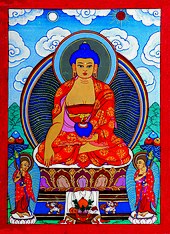
Buddha (Tantric Buddhism) by Otgonbayar Ershuu
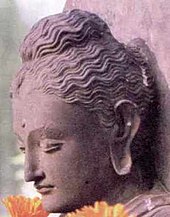
Siddhartha Gautama (or Buddha Shakyamuni - The sage from the lineage of Shakya)
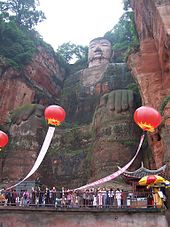
Buddha Maitreya (Leshan, China)
Etymology
The word "Buddha" means "the awakened one" and is the root form of the past participle of the verbal root budh ("awaken") in Sanskrit and in the Middle Indian languages derived from it. The nominative case of the word "Buddha" is buddhas in Sanskrit and buddho in the Middle Indian Pali language, and some scholars therefore use these forms. However, since in occidental scholarship Indian words are used in the root form rather than the nominative, following the example of native lexicographers and grammarians, the form buddha has become generally accepted.
Because Sanskrit is an Indo-European language, the verbal root budh or Indo-European *bheudh with the meaning "to awaken, to pay attention to, to make attentive" is also found in a modified form in many European languages. For example, the German word "Gebot" and the word "Buddha" are linguistically related.
Buddha Shakyamuni
→ Main article: Siddhartha Gautama
From birth to starting a family
Siddhartha Gautama lived around 500 BC in northern India; his birthplace is considered to be Lumbini. His father Suddhodana was head of one of the ruling families in the small noble republic of the Shakya in northern India in what is now the Indo-Nepal border region. References to the royal status of Buddha's father and to the pomp and ceremonies of his court, which are encountered especially in later texts, are most likely exaggerations; it is probable, however, that the family belonged at least to the nobility. His mother's name was Maya, and she died seven days after the child's birth. The parents named their son Siddhattha (in Pali) or Siddhartha (in Sanskrit), which means "he who has attained his goal." The epithet Shakyamuni refers to his origin and means "the sage from the lineage of Shakya". After Siddhartha's birth, it was predicted that he would either become a world ruler or, realizing the suffering of the world, someone who would bring wisdom to the world. He lived in a palace where everything that belonged to well living was at his disposal and where, according to tradition, he was shielded from all worldly suffering. His father saw in him the ideal successor and wanted to prevent Siddhartha from turning away from his kingdom. Therefore, he was rarely allowed to leave the royal palace, and when he did, the streets were cleared of the old, the sick, and the dying beforehand.
From the exits to the awakening
Siddhartha was told by the Indian deity Brahma that in his last life he promised to use his next life to free humanity from suffering.
One day, however, he was confronted with the reality of life and the suffering of humanity and realized the futility of his life: The legend tells of encounters with an old man, a fever-stricken man, a decaying corpse, and finally a monk, whereupon he decided to search for a way out of general suffering. (However, in the "biography" of the Buddha, it is very difficult to separate legend from fact). At the age of 29, soon after the birth of his only son Rahula ("fetter"), he left his child, his wife Yasodhara, and his home and became an ascetic in search of salvation. For six years the ascetic Gautama wandered the Ganges plain, met famous religious teachers, studied and followed their systems and methods, and subjected himself to rigorous ascetic exercises. Since none of this brought him closer to his goals, he abandoned the traditional religions and their methods and sought his own path, practicing meditation above all. He called this the "Middle Way" because it avoided the extremes of other religious teachings.
Siddhartha Gautama "attained" perfect awakening (Bodhi) in his 35th year. This happened on the banks of the Neranjara River at Bodhgaya (near Gaya in today's Bihar) under a poplar fig, which today is revered as the Bodhi tree, "tree of wisdom". According to legend, an offshoot of that very fig tree was planted in Sri Lanka while the Indian tree withered. From there, an offshoot was later taken and planted in the original place in India (near the temple district of Sarnath, excavated in 1931).
His life as a teacher
After the Bodhi experience, Gautama, the Buddha, gave his first teaching discourse to a group of five ascetics, his former companions, in the wildlife park at Isipatana (now Sarnath) near Benares. These five thus became the first monks of the Buddhist monastic community (Sangha). From that day on, he taught and spoke for 45 years before men and women of all walks of life, kings and peasants, brahmins and outcasts, moneylenders and beggars, saints and robbers. He accepted as a given the caste distinctions that still exist in India today, but emphasized their irrelevance to the path he was teaching.
Buddha is said to have died at the age of 80 and entered Parinirvana.
The aftermath of his life
At the first Buddhist Council ("of the Five Hundred"), which met in a cave near Rajagriha (Rājagṛha, Pali: Rājagaha) immediately after the extinguishment of the Enlightened One, Ānanda, who was known for his excellent memory, is said to have recited the doctrinal discourses. Mahakashyapa recited the Abidharma and Upali the monastic precepts.
Tradition reports that a canon of doctrine (dharma) and one of religious discipline (vinayapitaka) were compiled at this council. A text purporting to report on this, Kāśyapasaṃgīti-sūtra is preserved in the Chinese canon (Taishō no. 2027).
From the perspective of religious phenomenology, Gautama as a religious authority embodies the type of the "founder", the "mystic" and the "teacher". The American universal historian Jerry H. Bentley, like many other scholars before him, pointed out striking parallels in the lives of Jesus and Buddha.
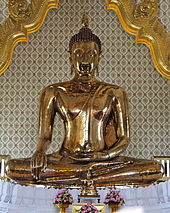
Thai Buddha Statue
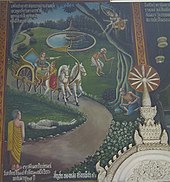
The four exits: Siddhartha encounters an old man, a fever-stricken man, a corpse and an ascetic in Buddhist monk's clothing
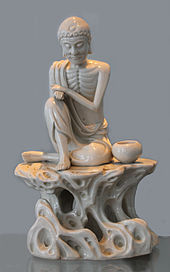
Ascetic Buddha

Buddha statue in Borobudur (Java, Indonesia)
Questions and Answers
Q: What is a Buddha in Buddhism?
A: A Buddha is the holiest type of being in Buddhism, a teacher of God's and humans.
Q: What does the word Buddha mean?
A: The word Buddha means "enlightened one" in Sanskrit or Fully Awakened One in Pāli.
Q: Who is Siddhartha Gautama?
A: Siddhartha Gautama was the man who started Buddhism and a title for Buddha.
Q: What is another name for Siddhartha Gautama?
A: Sometimes people call him "the Buddha" or the "Shakyamuni Buddha".
Q: Can any person be called a Buddha in Buddhism?
A: Yes, sometimes people call any person a Buddha if they have found enlightenment.
Q: What is a bodhisattva in Buddhism?
A: If a person has not found enlightenment yet, but is very close to reaching it, then he is called bodhisattva.
Q: What does the title Buddha imply in Buddhism?
A: The title Buddha implies a person who has attained full enlightenment and serves as a teacher to others on the path towards enlightenment.
Search within the encyclopedia